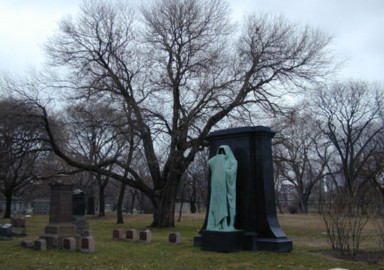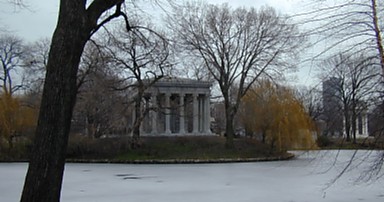More tales from the Graves
Dexter Graves, that is. Not a lot is known about the man, other than that he was one of the first Chicagoans, he ran a hotel, and he died around 1844. About 65 years later, a new monument was commissioned for his gravesite, titled Eternal Silence. It might be one of the most chilling representations of Death ever created. Some say that, like a vampire, it can't be photographed, but as you can see, my camera proved them wrong.

The figure of Death was sculpted by Lorado Taft, whose far less creepy Alma Mater statue is familiar to alumni of the Univeristy of Illinois.
Be forewarned -- I could go on for weeks about everything I saw at Graceland Cemetery! The following picture is of the massive Palmer monument:

In the late 1800s, Potter and Bertha Palmer thought of themselves as Chicago royalty, and the temple they erected to their memories testifies to that. I took this picture from across a small pond in the center of the cemetery. Near where I was standing are buried Ludwig Mies van der Rohe, Bruce Goff, and Ruth Page, all modernists (in contrast to Lorado Taft).
At the north end of the pond is a tiny island on which lies the remains of architect and urban planner Daniel Burnham (who was more of a Lorado Taft kind of guy). The island is landscaped in a naturalistic style, possibly in homage to Burnham's colleague Frederick Law Olmsted, who was the architect of Jackson Park's Wooded Island. The path to the island was a muddy mess the day I was there -- Olmsted would not have approved.

0 Comments:
Post a Comment
<< Home